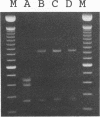Abstract
The VP4 (P) and VP7 (G) types of 171 rotavirus isolates obtained from children with diarrhea in the United States were characterized by PCR typing assays. Strains P1G1 predominated (71%); this was followed by strains P1G3 (20%) and P2G2 and P1G4 (2% each). Mixed types were identified in five (3%) specimens. Two (1%) strains bearing the P3 genotype (P3G1 and P3G2) were found in children with severe dehydrating diarrhea, although the P3 genotype has been regarded as a possible marker for virus attenuation.
Full text
PDF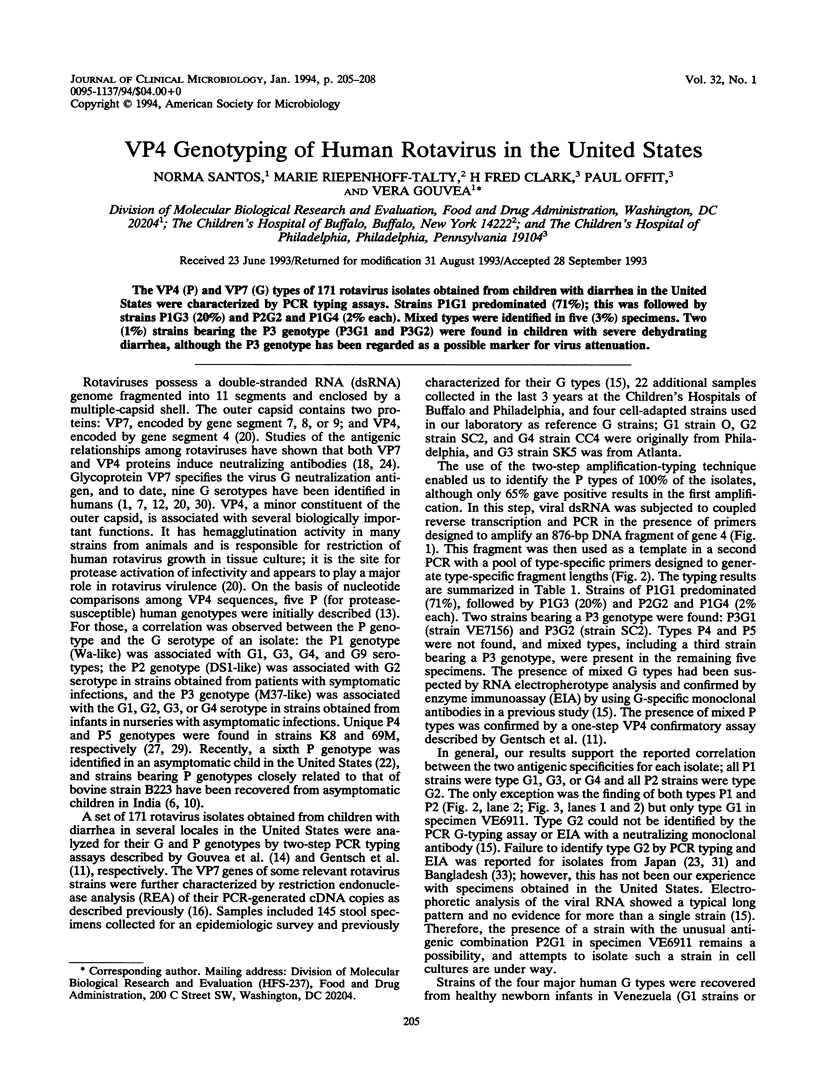
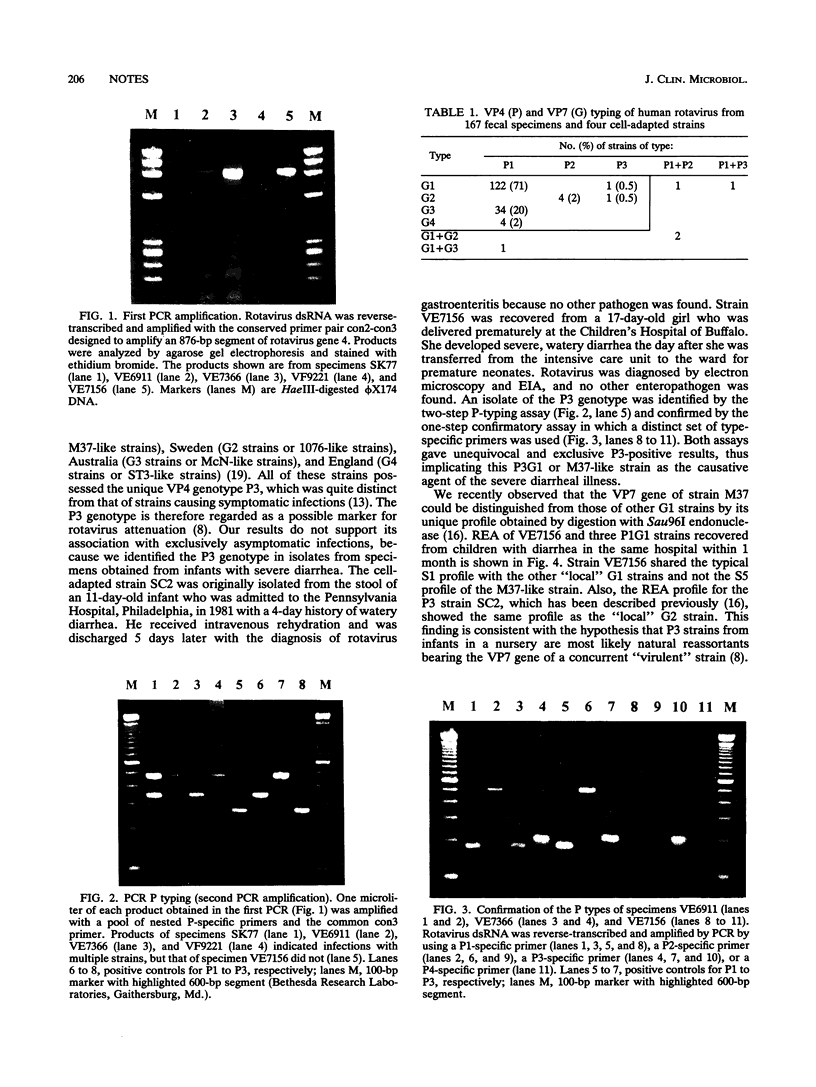
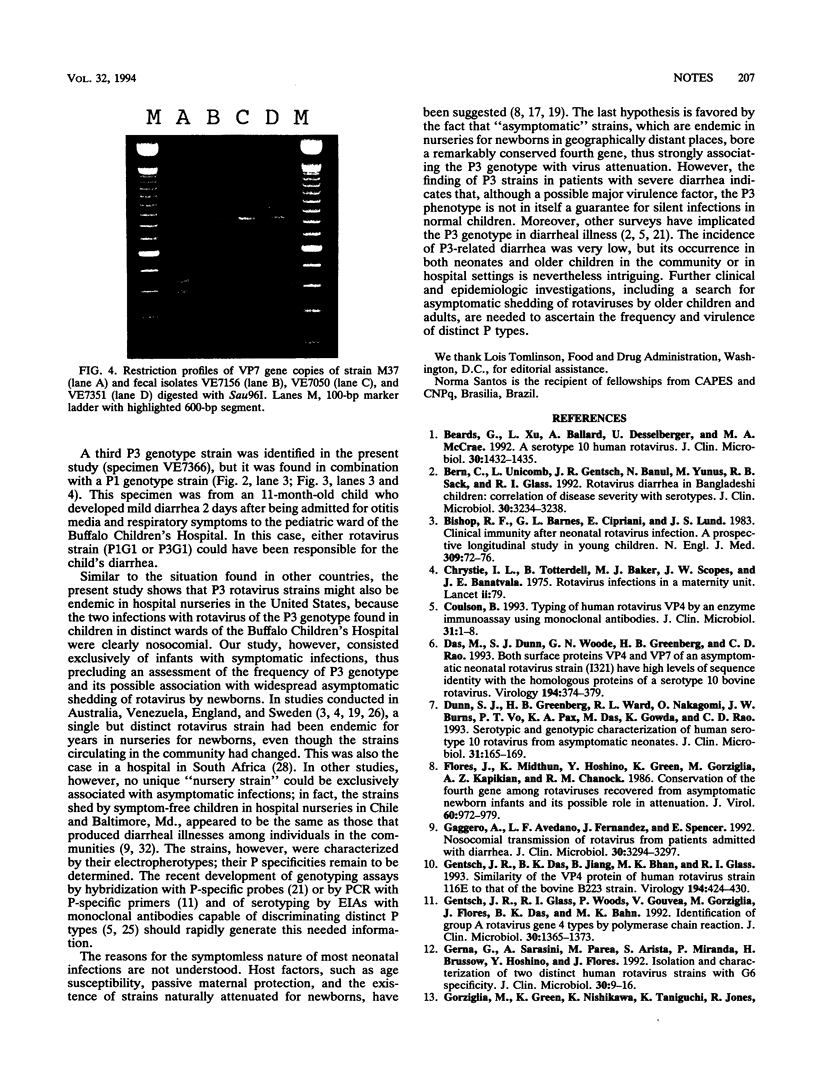
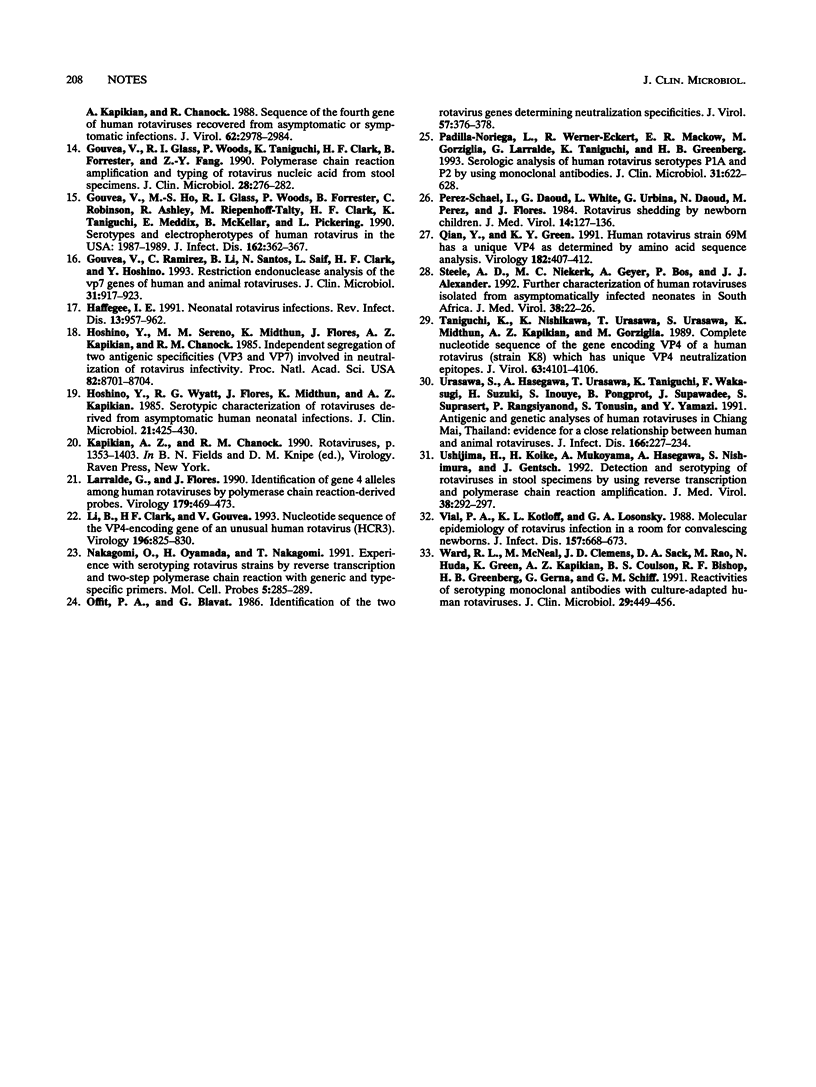
Images in this article
Selected References
These references are in PubMed. This may not be the complete list of references from this article.
- Beards G., Xu L., Ballard A., Desselberger U., McCrae M. A. A serotype 10 human rotavirus. J Clin Microbiol. 1992 Jun;30(6):1432–1435. doi: 10.1128/jcm.30.6.1432-1435.1992. [DOI] [PMC free article] [PubMed] [Google Scholar]
- Bern C., Unicomb L., Gentsch J. R., Banul N., Yunus M., Sack R. B., Glass R. I. Rotavirus diarrhea in Bangladeshi children: correlation of disease severity with serotypes. J Clin Microbiol. 1992 Dec;30(12):3234–3238. doi: 10.1128/jcm.30.12.3234-3238.1992. [DOI] [PMC free article] [PubMed] [Google Scholar]
- Bishop R. F., Barnes G. L., Cipriani E., Lund J. S. Clinical immunity after neonatal rotavirus infection. A prospective longitudinal study in young children. N Engl J Med. 1983 Jul 14;309(2):72–76. doi: 10.1056/NEJM198307143090203. [DOI] [PubMed] [Google Scholar]
- Chrystie I. L., Totterdell B., Baker M. J., Scopes J. W., Banatvala J. E. Letter: Rotavirus infections in a maternity unit. Lancet. 1975 Jul 12;2(7924):79–79. doi: 10.1016/s0140-6736(75)90525-5. [DOI] [PubMed] [Google Scholar]
- Coulson B. S. Typing of human rotavirus VP4 by an enzyme immunoassay using monoclonal antibodies. J Clin Microbiol. 1993 Jan;31(1):1–8. doi: 10.1128/jcm.31.1.1-8.1993. [DOI] [PMC free article] [PubMed] [Google Scholar]
- Das M., Dunn S. J., Woode G. N., Greenberg H. B., Rao C. D. Both surface proteins (VP4 and VP7) of an asymptomatic neonatal rotavirus strain (I321) have high levels of sequence identity with the homologous proteins of a serotype 10 bovine rotavirus. Virology. 1993 May;194(1):374–379. doi: 10.1006/viro.1993.1271. [DOI] [PubMed] [Google Scholar]
- Dunn S. J., Greenberg H. B., Ward R. L., Nakagomi O., Burns J. W., Vo P. T., Pax K. A., Das M., Gowda K., Rao C. D. Serotypic and genotypic characterization of human serotype 10 rotaviruses from asymptomatic neonates. J Clin Microbiol. 1993 Jan;31(1):165–169. doi: 10.1128/jcm.31.1.165-169.1993. [DOI] [PMC free article] [PubMed] [Google Scholar]
- Flores J., Midthun K., Hoshino Y., Green K., Gorziglia M., Kapikian A. Z., Chanock R. M. Conservation of the fourth gene among rotaviruses recovered from asymptomatic newborn infants and its possible role in attenuation. J Virol. 1986 Dec;60(3):972–979. doi: 10.1128/jvi.60.3.972-979.1986. [DOI] [PMC free article] [PubMed] [Google Scholar]
- Gaggero A., Avendaño L. F., Fernández J., Spencer E. Nosocomial transmission of rotavirus from patients admitted with diarrhea. J Clin Microbiol. 1992 Dec;30(12):3294–3297. doi: 10.1128/jcm.30.12.3294-3297.1992. [DOI] [PMC free article] [PubMed] [Google Scholar]
- Gentsch J. R., Das B. K., Jiang B., Bhan M. K., Glass R. I. Similarity of the VP4 protein of human rotavirus strain 116E to that of the bovine B223 strain. Virology. 1993 May;194(1):424–430. doi: 10.1006/viro.1993.1280. [DOI] [PubMed] [Google Scholar]
- Gentsch J. R., Glass R. I., Woods P., Gouvea V., Gorziglia M., Flores J., Das B. K., Bhan M. K. Identification of group A rotavirus gene 4 types by polymerase chain reaction. J Clin Microbiol. 1992 Jun;30(6):1365–1373. doi: 10.1128/jcm.30.6.1365-1373.1992. [DOI] [PMC free article] [PubMed] [Google Scholar]
- Gerna G., Sarasini A., Parea M., Arista S., Miranda P., Brüssow H., Hoshino Y., Flores J. Isolation and characterization of two distinct human rotavirus strains with G6 specificity. J Clin Microbiol. 1992 Jan;30(1):9–16. doi: 10.1128/jcm.30.1.9-16.1992. [DOI] [PMC free article] [PubMed] [Google Scholar]
- Gorziglia M., Green K., Nishikawa K., Taniguchi K., Jones R., Kapikian A. Z., Chanock R. M. Sequence of the fourth gene of human rotaviruses recovered from asymptomatic or symptomatic infections. J Virol. 1988 Aug;62(8):2978–2984. doi: 10.1128/jvi.62.8.2978-2984.1988. [DOI] [PMC free article] [PubMed] [Google Scholar]
- Gouvea V., Glass R. I., Woods P., Taniguchi K., Clark H. F., Forrester B., Fang Z. Y. Polymerase chain reaction amplification and typing of rotavirus nucleic acid from stool specimens. J Clin Microbiol. 1990 Feb;28(2):276–282. doi: 10.1128/jcm.28.2.276-282.1990. [DOI] [PMC free article] [PubMed] [Google Scholar]
- Gouvea V., Ho M. S., Glass R., Woods P., Forrester B., Robinson C., Ashley R., Riepenhoff-Talty M., Clark H. F., Taniguchi K. Serotypes and electropherotypes of human rotavirus in the USA: 1987-1989. J Infect Dis. 1990 Aug;162(2):362–367. doi: 10.1093/infdis/162.2.362. [DOI] [PubMed] [Google Scholar]
- Gouvea V., Ramirez C., Li B., Santos N., Saif L., Clark H. F., Hoshino Y. Restriction endonuclease analysis of the vp7 genes of human and animal rotaviruses. J Clin Microbiol. 1993 Apr;31(4):917–923. doi: 10.1128/jcm.31.4.917-923.1993. [DOI] [PMC free article] [PubMed] [Google Scholar]
- Haffejee I. E. Neonatal rotavirus infections. Rev Infect Dis. 1991 Sep-Oct;13(5):957–962. doi: 10.1093/clinids/13.5.957. [DOI] [PubMed] [Google Scholar]
- Hoshino Y., Sereno M. M., Midthun K., Flores J., Kapikian A. Z., Chanock R. M. Independent segregation of two antigenic specificities (VP3 and VP7) involved in neutralization of rotavirus infectivity. Proc Natl Acad Sci U S A. 1985 Dec;82(24):8701–8704. doi: 10.1073/pnas.82.24.8701. [DOI] [PMC free article] [PubMed] [Google Scholar]
- Hoshino Y., Wyatt R. G., Flores J., Midthun K., Kapikian A. Z. Serotypic characterization of rotaviruses derived from asymptomatic human neonatal infections. J Clin Microbiol. 1985 Mar;21(3):425–430. doi: 10.1128/jcm.21.3.425-430.1985. [DOI] [PMC free article] [PubMed] [Google Scholar]
- Larralde G., Flores J. Identification of gene 4 alleles among human rotaviruses by polymerase chain reaction-derived probes. Virology. 1990 Nov;179(1):469–473. doi: 10.1016/0042-6822(90)90317-k. [DOI] [PubMed] [Google Scholar]
- Li B., Clark H. F., Gouvea V. Nucleotide sequence of the VP4-encoding gene of an unusual human rotavirus (HCR3). Virology. 1993 Oct;196(2):825–830. doi: 10.1006/viro.1993.1540. [DOI] [PubMed] [Google Scholar]
- Nakagomi O., Oyamada H., Nakagomi T. Experience with serotyping rotavirus strains by reverse transcription and two-step polymerase chain reaction with generic and type-specific primers. Mol Cell Probes. 1991 Aug;5(4):285–289. doi: 10.1016/0890-8508(91)90051-k. [DOI] [PubMed] [Google Scholar]
- Offit P. A., Blavat G. Identification of the two rotavirus genes determining neutralization specificities. J Virol. 1986 Jan;57(1):376–378. doi: 10.1128/jvi.57.1.376-378.1986. [DOI] [PMC free article] [PubMed] [Google Scholar]
- Padilla-Noriega L., Werner-Eckert R., Mackow E. R., Gorziglia M., Larralde G., Taniguchi K., Greenberg H. B. Serologic analysis of human rotavirus serotypes P1A and P2 by using monoclonal antibodies. J Clin Microbiol. 1993 Mar;31(3):622–628. doi: 10.1128/jcm.31.3.622-628.1993. [DOI] [PMC free article] [PubMed] [Google Scholar]
- Perez-Schael I., Daoud G., White L., Urbina G., Daoud N., Perez M., Flores J. Rotavirus shedding by newborn children. J Med Virol. 1984;14(2):127–136. doi: 10.1002/jmv.1890140206. [DOI] [PubMed] [Google Scholar]
- Qian Y., Green K. Y. Human rotavirus strain 69M has a unique VP4 as determined by amino acid sequence analysis. Virology. 1991 May;182(1):407–412. doi: 10.1016/0042-6822(91)90691-4. [DOI] [PubMed] [Google Scholar]
- Steele A. D., van Niekerk M. C., Geyer A., Bos P., Alexander J. J. Further characterisation of human rotaviruses isolated from asymptomatically infected neonates in South Africa. J Med Virol. 1992 Sep;38(1):22–26. doi: 10.1002/jmv.1890380106. [DOI] [PubMed] [Google Scholar]
- Taniguchi K., Nishikawa K., Urasawa T., Urasawa S., Midthun K., Kapikian A. Z., Gorziglia M. Complete nucleotide sequence of the gene encoding VP4 of a human rotavirus (strain K8) which has unique VP4 neutralization epitopes. J Virol. 1989 Sep;63(9):4101–4106. doi: 10.1128/jvi.63.9.4101-4106.1989. [DOI] [PMC free article] [PubMed] [Google Scholar]
- Urasawa S., Hasegawa A., Urasawa T., Taniguchi K., Wakasugi F., Suzuki H., Inouye S., Pongprot B., Supawadee J., Suprasert S. Antigenic and genetic analyses of human rotaviruses in Chiang Mai, Thailand: evidence for a close relationship between human and animal rotaviruses. J Infect Dis. 1992 Aug;166(2):227–234. doi: 10.1093/infdis/166.2.227. [DOI] [PubMed] [Google Scholar]
- Ushijima H., Koike H., Mukoyama A., Hasegawa A., Nishimura S., Gentsch J. Detection and serotyping of rotaviruses in stool specimens by using reverse transcription and polymerase chain reaction amplification. J Med Virol. 1992 Dec;38(4):292–297. doi: 10.1002/jmv.1890380412. [DOI] [PubMed] [Google Scholar]
- Vial P. A., Kotloff K. L., Losonsky G. A. Molecular epidemiology of rotavirus infection in a room for convalescing newborns. J Infect Dis. 1988 Apr;157(4):668–673. doi: 10.1093/infdis/157.4.668. [DOI] [PubMed] [Google Scholar]
- Ward R. L., McNeal M. M., Clemens J. D., Sack D. A., Rao M., Huda N., Green K. Y., Kapikian A. Z., Coulson B. S., Bishop R. F. Reactivities of serotyping monoclonal antibodies with culture-adapted human rotaviruses. J Clin Microbiol. 1991 Mar;29(3):449–456. doi: 10.1128/jcm.29.3.449-456.1991. [DOI] [PMC free article] [PubMed] [Google Scholar]






